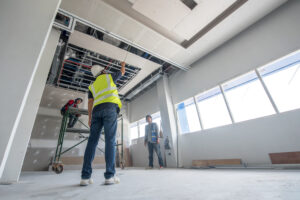Can any building be smart? Yes (we like to be straightforward with our answers), any building can be smart, regardless of its age, size, or layout. But with the help of smart building technologies.
The misconception that only modern buildings can be smart is widespread, but it’s not accurate.
Take the example of the Empire State Building, built in 1931.
However, in the last decade, it underwent a retrofitting process (will explain it further on) that incorporated smart technology.
As a result, the building has seen a remarkable 38% decrease in energy consumption, which translates into $4.4 million in energy savings each.
The idea that smart buildings are expensive or require invasive installation is also a myth.
The most crucial aspect of creating a smart building is identifying your priorities.
- What do you want your building to achieve?
- What will people use these buildings for?
- Do you want a space that’s safe and secure, or are you more concerned with hitting specific energy targets?
- How should the design of these buildings address people’s needs?
Access to accurate data is also essential in creating a smart building.
With the right sensors and monitoring systems in place, you can gather real-time information about your building’s performance and use that data to make informed decisions.
Finally, it’s worth noting that creating a smart building doesn’t have to be an all-or-nothing proposition.
You can start small, implementing a few smart building technologies, and then gradually expand your system as your needs and budget allow.
With the right approach, any building can become smart and more efficient, comfortable, and secure.
So… What was retrofitting?

Retrofitting is a process that involves renovating or upgrading an existing building to bring it up to modern standards.
This can include refurbishing outdated systems and making modifications to enhance the building’s sustainability, energy efficiency, and overall performance.
While before, retrofitting meant installing smart thermostats and daylight sensors, etc., etc., today it’s much more than that.
In recent years, retrofitting has also involved the installation of an Internet of Things (IoT) network.
This is what makes the buildings really, really smart.
This enables various systems to communicate and share data, creating a more integrated and efficient building ecosystem.
By integrating smart building technologies and creating a connected building environment, retrofitting can transform older buildings into modern, sustainable, and healthy spaces for their occupants.
How to make an old building smart?
Conduct an assessment
Before you do anything else, it’s essential to assess the current infrastructure thoroughly.
This will help identify areas that need improvement and determine what kind of smart building technologies can be integrated.
The assessment will help determine the scope of the project, the budget, and the timeline.
Upgrade the infrastructure
Old buildings may have outdated electrical and mechanical systems that cannot support smart technology.
Upgrading the infrastructure may involve replacing old wiring, installing new HVAC systems, or upgrading the lighting system.
These upgrades will help ensure the technology can be installed and function correctly.
Install sensors
Sensors are critical components of smart buildings, and they’re responsible for collecting data that the Building Management System (BMS) can use to control the building’s systems.
Temperature, humidity, occupancy, and energy consumption sensors are essential for a smart building to function properly.
Implement a Building Management System (BMS)
BMS is the central hub that controls ALL the building systems.
It allows for automation and intelligent control, making it easier to manage the building’s operations.
A BMS will integrate with the sensors and other smart technology installed in the building to create a cohesive system.
Consider energy-saving measures
Smart buildings are designed to be energy-efficient, which can lead to significant cost savings.
LED lighting, smart thermostats, and renewable energy sources are all ways to make an old building more energy-efficient.
However, sometimes all you need is the right sensor to see where you’re WASTING most of your energy.
These measures will reduce the building’s carbon footprint and make it more sustainable.
Ensure privacy and security.
With smart technology, it’s important to prioritize privacy and security.
Anonymous data collection, access controls, and secure networks are all ways to protect building occupants’ privacy and ensure that the building’s data is secure.
To wrap it up
By retrofitting the building and incorporating smart building technologies, owners can really make a change…
…For their occupants and their wallet.
You can future-proof your properties and reap the benefits of a more efficient and sustainable building.
